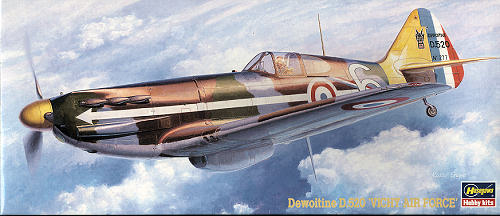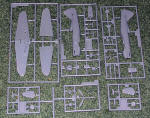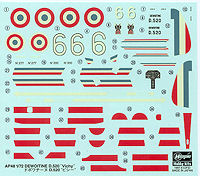
| KIT: | Hasegawa 1/72 Dewoitine D.520 'Vichy Air Force' |
| KIT #: | 51348 |
| PRICE: | $14.95 MSRP when new |
| DECALS: | Two Options |
| REVIEWER: | Scott Van Aken |
| NOTES: |

| HISTORY |
Design of the Dewoitine 520 started in November 1936 at the private design firm led by Emile Dewoitine. Trying to address problems in earlier designs, he created a fighter using only the latest techniques and engines. The new design was to be able to reach 520 km/h and became known as the "520". Only months later the firm was conglomerated into one of a number of design-and-manufacturing pools, in this case SNCAM. Still known as the D.520, work on the design continued at the new company.
The prototype D.520 flew on October 2, 1938, powered by the new 890 hp (660 kW) Hispano-Suiza 12Y-21 liquid-cooled engine. The plane managed to reach only 480 km/h in flight tests, much slower than expected. Most of the problem seemed to come from greater than expected drag from the underwing radiators, so these were merged into a single radiator under the fuselage. After minor damage in a landing accident the engine was changed to a newer -29 and included exhaust ejectors for added thrust, along with an adjustable prop. These changes were enough to allow the plane to reach its design speed.
The prototype was followed in 1939 with two airframes with a new sliding canopy and a larger tail unit. These were armed with a 20 mm cannon firing through the propeller spinner (a feature later found on many German and Russian designs) and two 7.5 mm machine guns in small pods under the wing. The third also included a small tail-wheel instead of the original skid. Flight tests went fairly well and a contract for 200 production machines to be powered by the newer -31 engine (later replaced by the -45) was issued in March of 1939. A contract for an additional 600 planes was issued in June reduced to 510 in July.
With the outbreak of war a new contract brought the total to 1280, with the production rate to be 200 machines per month from May 1940. The Aeronavale then ordered 120. Another Armée de Air order in April 1940 brought the total to 2250 and increased quotas to 350 a month. Needless to say, not all the orders were filled.
The first production D.520 flew in November, powered by the 830 hp (620 kW) 12Y-31 and armed with two 7.5 mm machine guns in housings underneath the wings. It had a curved, one-piece windshield and a sliding canopy. The rest of the production machines were delivered with the 930 hp (690 kW) 12Y-45 engine with a new supercharger and a Ratier 3-bladed propeller (a few had the -49 of 910 hp (680 kW)). They were armed with a Hispano-Suiza 404 20 mm cannon firing through the propeller hub and four MAC 1934 7.5 mm machine guns in the wings. The curved, one-piece windshield from the prototypes was replaced with one containing an optically-flat panel.
| THE KIT |
 I've
not built this kit and in fact, when looking through the stash for one to do,
rarely does my hand stop near it. I'm not sure why, but there it is. This one in
done in the fashion that Hasegawa is known and is a special boxing of a base
kit. This 1997 boxing is for the Vichy Air Force, and that means just a decal
change.
I've
not built this kit and in fact, when looking through the stash for one to do,
rarely does my hand stop near it. I'm not sure why, but there it is. This one in
done in the fashion that Hasegawa is known and is a special boxing of a base
kit. This 1997 boxing is for the Vichy Air Force, and that means just a decal
change.
As is the norm with Hasegawa 1/72 kits, the interior is adequate for the scale but by no means well detailed. A simple floor, generic looking seat, control stick and instrument panel are provided with a decal for the instruments. A reflector gun sight is provided with its mount. You are offered options with the spinner (one shorter than the other) and in the tail wheel. There is no indication as to which tail wheel is for which markings option.
I found
little in the way of flaws, however, there are two large sink areas on each
fuselage half opposite some interior bulwarks. These are of a similar size to
the sink areas on the Accurate Miniatures Vindicator, yet I don't recall any hu e
and cry over them. Clear bits (not shown) are well done with the canopy and
windscreen molded as one piece with the quarter windows separate.
e
and cry over them. Clear bits (not shown) are well done with the canopy and
windscreen molded as one piece with the quarter windows separate.
Instructions are what we've come to expect from Hasegawa with Gunze color information. I find it interesting that they've chosen Neutral Grey for the cockpit interior as my understanding was that a dark blue was standard for French interiors. Well, your choice on this. Markings are for two Vichy aircraft. One is the box art plane in full red and yellow 'prisoners stripes' from GC III/6. The red bits are on the sheet so one only has to do the yellow. For those who are a bit squeamish about all the stripes, there is a GC III/6 option with just the yellow tail and no red stripes. The decals are well printed and old school Hasegawa with the ivory white that is generally a tad transparent.
| CONCLUSIONS |
Though I've not done a real 'weekend' build since I was 14, I know that the term refers to a kit that will provide minimum hassle and can be built relatively quickly. This is one of those kits. Despite the sink marks, it should prove to be a most pleasant building experience and makes into a fine model that surely surpasses the older kits from Heller and Frog. Though it has not been in the catalogue for several years, it should be easy enough to find.
| REFERENCES |
Wikipedia
October 2006 If you would like your product reviewed fairly and quickly by a
site that has over 325,000 visitors a month, please
contact
me or see other details in the
Note to
Contributors.